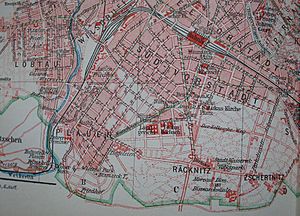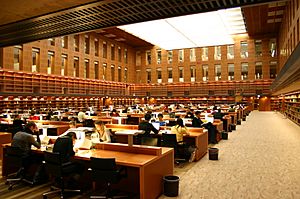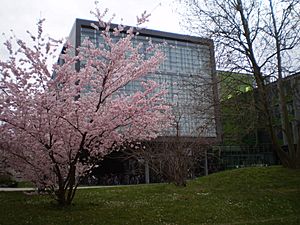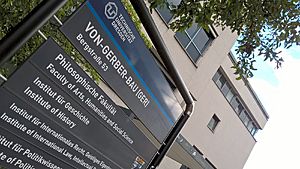TU Dresden facts for kids
|
Technische Universität Dresden
|
|
 |
|
| Motto |
Wissen schafft Brücken (German)
|
|---|---|
|
Motto in English
|
Knowledge builds bridges |
| Type | Public |
| Established | 1828 |
|
Academic affiliations
|
German Universities Excellence Initiative, PEGASUS, TIME, CESAER, TU9, DRESDEN-concept |
| Budget | € 577.8 million (2017) |
| President | Ursula Staudinger |
|
Academic staff
|
5,751 |
|
Administrative staff
|
2,470 |
| Students | 28,952 |
| Location |
,
,
Germany
51°1′41″N 13°43′36″E / 51.02806°N 13.72667°E |
| Campus | Urban |
TU Dresden is a big public university in Dresden, Germany. Its full name in German is German: Technische Universität Dresden. It's often called TUD for short. This university is the biggest one in Dresden and in the German state of Saxony. It's also one of the 10 largest universities in all of Germany.
The university has a long history, starting almost 200 years ago in 1828. It is one of the oldest technical colleges in Germany. Today, it's a full university that teaches many different subjects. TU Dresden is part of TU9, which is a group of nine leading technical universities in Germany. It was also named a "University of Excellence" in 2012, which means it's recognized for its top-notch research and teaching.
Contents
History of TU Dresden
In 1828, as industries grew, a school called the Saxon Technical School was started. Its goal was to train skilled workers in areas like mechanics and engineering. In 1871, when the German Empire was formed, the school changed its name to the Royal Saxon Polytechnic Institute. At this time, new subjects like history and languages were added.
By the end of the 1800s, the institute had grown into a university that taught many different subjects. It was called Technische Hochschule from 1919. In 1961, it got its current name, Technische Universität Dresden, or TU Dresden.
Changes Over Time
The university went through challenging times in the 1930s. Later, during the time of the German Democratic Republic (GDR), the university continued to develop. In 1986, it welcomed the Dresden College of Engineering.
After Germany Reunited
After Germany reunited in 1990, TU Dresden grew even more. It added the College of Forestry, which was once the Royal Saxony Academy of Forestry. It also joined with the Friedrich List College of Transport and the "Carl-Gustav Carus" Medical Academy. New departments were also created, like those for Information Technology, Law, Education, and Economics.
In 2009, TU Dresden and other big research centers in Dresden created a plan called DRESDEN-Konzept. This plan aims to make Dresden a worldwide leader in research and education.
Campus Life
TU Dresden has a campus where most of its buildings are close together. Some buildings are very old, over a hundred years old, and have beautiful designs. Newer, modern buildings have also been added, like the library and the main lecture hall.
The main campus is located south of the city center of Dresden. The medical department has its own campus in a different part of the city. The forestry department is located in a forest area in the nearby town of Tharandt.
How TU Dresden is Organized
TU Dresden has 17 different departments, called faculties. Most of these are on the main campus. The medical faculty and the forestry department are in separate locations.
Science Studies
The School of Sciences has five faculties: Biology, Chemistry, Mathematics, Physics, and Psychology. All these are on the main campus. Researchers here study things like how cells work and how to create new tissues for medical uses.
Engineering Studies
- The Faculty of Architecture and Landscape teaches students about designing buildings and outdoor spaces.
- The Faculty of Civil Engineering focuses on building structures like bridges and roads. It's the oldest engineering department.
- The Faculty of Computer Science teaches about computers, artificial intelligence, and software. It has many students.
- The Faculty of Electrical Engineering and Information Technology is important for the "Silicon Saxony" area in Dresden, which is a big center for microelectronics.
- The Faculty of Environmental Sciences studies the environment. Its forestry department in Tharandt is the oldest of its kind in Germany.
- The Faculty of Mechanical Engineering is the largest department at TU Dresden. It teaches about how machines work and are built.
- The Faculty of Transport and Traffic Sciences "Friedrich List" is unique in Germany. It covers everything about transport, from how it affects the economy to how vehicles are engineered.
Humanities and Social Sciences
- The Faculty of Business and Economics teaches about business, money, and how companies work.
- The Faculty of Education focuses on teaching and learning.
- The Faculty of Languages, Literature and Culture studies different languages, books, and cultures.
- The Faculty of Philosophy explores subjects like history, music, politics, and how people think.
- The School of International Studies helps students learn about international law, economics, and global relations.
Medical Studies
- The Carl Gustav Carus Faculty of Medicine has its own campus. It teaches students to become doctors and works with other medical schools around the world.
Research Centers
TU Dresden also has special research centers. These include centers for advanced electronics, regenerative therapies (which study how to heal and regrow body parts), and research on totalitarianism.
Research at TU Dresden
TU Dresden is known for its strong research, especially in microelectronics and transport. It also explores new areas like biotechnology.
Biotechnology and Medical Technology
The university works closely with other research institutes on molecular bioengineering. They have special programs that focus on how cells become tissues and how to use this knowledge for new medical treatments. They study things like genomics (how genes work), proteomics (how proteins work), and tissue engineering (creating new tissues).
Other Research Areas
The university also does research in areas like magnetism, new materials, and nanotechnology (working with very tiny things). Because Dresden is a big center for microelectronics, TU Dresden is a leader in nanotechnology. They also research IT systems for public transport and economic development.
The university works with many famous research groups in Germany, like the Fraunhofer Society and the Max Planck Society. TU Dresden also received a large grant to build a special computer called "spincloud" for brain research.
University Rankings
| University rankings | ||||||||||
|---|---|---|---|---|---|---|---|---|---|---|
| Overall – Global & National | ||||||||||
|
||||||||||
Universities are often ranked to show how good they are. TU Dresden is recognized in several of these rankings. For example, in 2024, it was ranked among the top universities worldwide by QS World University Rankings and Times Higher Education World University Rankings. It also ranked well in engineering and technology subjects.
Working with Other Countries
TU Dresden works with many leading universities around the world. For example, it has a branch in Hanoi, Vietnam, where it offers a Master's degree in mechatronics. It also has partnerships with universities in the USA, China, and South Korea.
Student Life at TU Dresden
Who Studies Here?
About 35,000 students attend TU Dresden. A large number of students come from Saxony, the state where Dresden is located. Many also come from other parts of Germany and from other countries around the world. The biggest groups of international students come from Europe and Asia, especially from China and Poland.
The main language for lessons at most departments is German. Many international students take German language courses to prepare for their studies. The university has an International Office that helps foreign students. There are also many activities and programs to help international students feel at home and make new friends.
Fun Activities
Students at TU Dresden enjoy sports. There are also many student clubs. The summer campus party is known as one of the biggest in Germany. The university has cafeterias where students can eat, and the main dining hall is very large.
Performing Arts
The university has several performing arts groups. These include a theater group, a folk dance group that performs traditional dances, a university choir, and a university orchestra. These groups often perform in Saxony and sometimes even in other countries.
Funding the University
TU Dresden is working to become more independent from government funding. It is very good at getting money for research from companies and other partners. In 2004, the university received over 100 million Euros for its projects from sources other than the government. This shows it has strong connections with industries.
Places to Visit
- Botanischer Garten der Technischen Universität Dresden, the university's botanical garden
- Forstbotanischer Garten Tharandt, the university's historic arboretum
- Archives of the university
Important People from TU Dresden
Many important people have been connected to TU Dresden.
Honorary Doctors
These are people who received a special honorary degree from the university.
- 1905 Wilhelm von Siemens – A famous industrialist.
- 1906 Ferdinand von Zeppelin – Known for his airships.
- 1928 Fredrik Ljungström – An engineer and inventor.
- 1981 Konrad Zuse – The civil engineer who built the world's first programmable computer.
- 1995 Václav Havel – A writer and the first president of the Czech Republic.
- 1999 Kofi Annan – A former leader of the United Nations.
- 2002 Walter Kohn – A physicist who won the Nobel Prize in Chemistry.
Honorary Senators
- 2000 Günter Blobel – Won the Nobel Prize in Physiology or Medicine.
Faculty Members
These are people who taught at the university.
- Manfred von Ardenne – A physicist.
- Heinrich Barkhausen – Known for his work in communications technology.
- Victor Klemperer – A professor who wrote important diaries during a difficult time in history.
- Richard von Mises – A mathematician.
- Maria Reiche – A mathematician and archaeologist.
- Paul Tillich – A philosopher.
Alumni
These are people who studied at the university.
- Fritz Bleyl – An architect and painter.
- Carl Enckell – A Finnish politician.
- Katja Kipping – A German politician.
- Max Littmann – A famous architect.
- Reimund Neugebauer – The President of the Fraunhofer Society.
- Stanislaw Tillich – A politician who was the Minister-President of Saxony.
See also
 In Spanish: Universidad Técnica de Dresde para niños
In Spanish: Universidad Técnica de Dresde para niños







